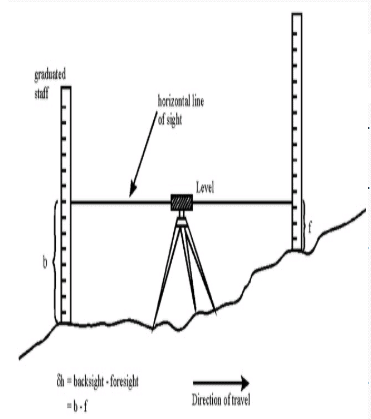Principles of Levelling - Simple Levelling and Fly Levelling methods, Surveying and Levelling | Surveying and Levelling Notes- Agricultural Engg - Agricultural Engineering PDF Download
PRINCIPLES OF LEVELLING
(a) Simple levelling: The operation of levelling for determining the difference in elevation, if not too great between two points visible from single position of the level is known as simple levelling.

Fig 10.1 Simple levelling
Procedure to be followed
- Level the instrument correctly.
- Direct the telescope towards the staff held
- Take the reading of Central, horizontal hair of the diaphram, where it appears to cut the staff ensuring that the bubble is central.
- Send the staff to next point
- Direct the telescope towards C and focus it again
- Check up the bubble if central, if not bring it to the Central position by the foot screw nearest to the telescope.
- Take the reading of Central Horizontal cross hair.
(b) Differential levelling or fly levelling: Any number of change points are established as required during levelling. This method is known as fly levelling.
It is adopted to find the difference in level between two points, when
(i) The two points are too far away
(ii) the difference in level between two points is large
(iii) there are no obstructions in between the two points concerned.
This method is used in order to find the difference in elevation between two points.
(i) If they are too far apart
(ii) if the difference in elevation between them is too great.
(iii) If there are obstacles intervening. In such case it is necessary to set up the level in several positions and to work in series of stages.
The difference of level of the points A&B is equal to the algebraic sum of these difference between the sum of back sights and sum of the fore sights i.e. Σ BS - Σ FS.

The elevation of change point
= Elevation of P + Back sight at P – Fore sight at change point (C.P)
= 100.00+1.60-1.10 = 100.50 m
The second height of the instrument
= The elevation of change point + Back Sight at change point
= 100.50+1.25 = 101.75 m
The elevation of Q
= The second height of instrument – foresight at Q
= 101.75 – 1.81 = 99.94 m
FAQs on Principles of Levelling - Simple Levelling and Fly Levelling methods, Surveying and Levelling - Surveying and Levelling Notes- Agricultural Engg - Agricultural Engineering
| 1. What is levelling in surveying? |  |
| 2. What are the principles of simple levelling? |  |
| 3. How does fly levelling differ from simple levelling? |  |
| 4. What are the applications of levelling in agricultural engineering? |  |
| 5. What are some common challenges faced during levelling surveys? |  |























